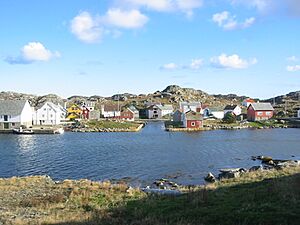Aasa Helgesen facts for kids
Quick facts for kids
Aasa Helgesen
|
|
|---|---|
| Born | 11 February 1877 Bjelland, Norway
|
| Died | 29 April 1968 (aged 91) |
| Nationality | Norwegian |
| Occupation | Midwife |
| Years active | 1903–1942 |
| Known for | Serving as mayor of Utsira from 1926 to 1928, she was the first female mayor in Norway. |
Aasa Helgesen (born Aasa Røinesdal, 11 February 1877 – 29 April 1968) was an important Norwegian midwife and politician. She made history by becoming the first female mayor in Norway. She served as mayor of Utsira, a small island, from 1926 to 1928. Before that, she worked as a midwife on Utsira for many years, from 1903 to 1942.
Contents
Aasa's Early Life and Midwife Work
Aasa was born in 1877 on a small farm called Røinesdal in Bjelland, a place in Southern Norway. After finishing primary school, she started working as a servant girl. But Aasa wanted to learn more. She managed to get a loan from a farmer and a local official (called a lensmann) to travel to Kristiania (now Oslo). There, she trained to become a midwife.
She finished her training in 1902. A year later, she got a job as a midwife on the small fishing island of Utsira in Western Norway. In 1907, she married Sivert Helgesen, a local fisherman.
Aasa and Sivert had eight children. They also had a farm. Aasa often took care of the farm work when Sivert was away at sea. From 1903 to 1943, she helped deliver about 400 babies on Utsira. This was almost every child born on the island during that time! Since there was no doctor on the island, Aasa also helped with other health problems.
Becoming Norway's First Female Mayor
Utsira became its own separate local government area, called a municipality, in 1925. Before that, it was part of another area. An early council was chosen, and Aasa's husband, Sivert, became the temporary mayor.
The first real election for Utsira's local council happened on 29 October 1925. At this time, women had only been allowed to vote for ten years, if they were over 25 years old. The way the election worked was that the person with the most votes would be elected.
The men on the temporary council expected to be elected again. But a radio assistant named Reidar Nordås created a new list of candidates. This list included eleven women and one man, none of whom knew their names were on it! Aasa Helgesen was one of these women. Many of the women on the list were wives of the men on the temporary council. Aasa and the others didn't know about this new list until election day.
When the votes were counted, eleven women and one man were elected to the council. Aasa Helgesen was one of them. The local police tried to cancel the election. But the election board and the Norwegian Ministry of Justice said the results were valid.
It's not fully clear why this happened. Some believe Nordås made the list as a joke, thinking the election would be cancelled. Others think it was because of a local disagreement about taxes. Some families worried the new council would be strict about people not paying their taxes.
The only man elected to the council did not want to be mayor. So, in 1926, Aasa Helgesen was chosen. She became the first official mayor of Utsira, taking over from her husband. This made her the first female mayor in all of Norway!
At first, many local people felt embarrassed by the election results. They kept it a secret for about a week. When it was finally announced, local newspapers made fun of the council, calling it the "skirt regime." But the news also spread internationally. Aasa Helgesen received congratulation messages from women's groups in the US and Mexico.
Despite the jokes, the new council did a good job. Local news reported that the island's money situation was fine. As mayor, Aasa also took part in the bigger Rogaland county council meetings.
In the next election in 1928, Aasa and the other women did not run for re-election. Aasa's husband, Sivert Helgesen, then became mayor of Utsira.
Aasa Helgesen's Legacy
After the eleven women left the council, it was a long time before another woman was elected to Utsira's council. This happened in 1980.
In 1986, one of Aasa's daughters was asked on TV if she felt proud when her mother became mayor. The daughter replied, "Proud? No, it was such a shame." This shows how unusual and perhaps even difficult it was for women to be in charge back then.
In 2012, Marte Eide Klovning became Utsira's second female mayor.
To honor Aasa Helgesen, a statue of her was placed outside Utsira's town hall in 1994.
In 2013, Norway celebrated 100 years since women got the right to vote. To mark this, a play called "The female coup on Utsira" was performed. It was about Aasa and the surprising election. Aasa Helgesen's great-granddaughter even played her in the play!
Images for kids



